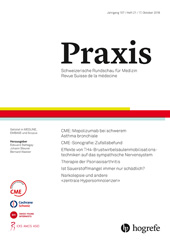Akute Effekte von TH4- Brustwirbelsäulenmobilisationstechniken auf das sympathische Nervensystem – eine Cross-over-Machbarkeitsstudie
Abstract
Zusammenfassung. Empirische Erkenntnisse über Effekte auf das sympathische Nervensystem bei Brustwirbelsäulenmobilisationen auf Höhe TH4 sind bis heute kaum vorhanden. Das primäre Ziel dieser Machbarkeitsstudie war, Adhärenzrate, Sicherheit und Untersuchungsverfahren und -durchführung zu evaluieren. Sekundär wurde der akute Effekt auf das sympathische Nervensystem der Mobilisationen nach anterior bzw. posterior an sechs gesunden Probanden an zwei aufeinanderfolgenden Tagen analysiert und interpretiert. Die Machbarkeit dieser Studie konnte gezeigt werden. Die Mobilisationen verursachten keine Beschwerden. Eine Tendenz zur Reduzierung der Herzfrequenz konnte für eine Brustwirbelsäulenmobilisation mit Schub nach anterior nachgewiesen werden.
Abstract. Up to date, empiric evidence about effects of thoracic spine mobilisation (TH4) on the sympathetic nervous system is lacking. The primary goal of this feasibility study was to determine adherence rate, side effects and the protocol as well as the implementation of the study design. The secondary goal was to analyse and interpret acute effects on the sympathetic nervous system after thoracic mobilisation in anterior thrust and posterior thrust on six healthy participants on two following days. The feasibility of this study was adequate. The spine mobilisations did not produce any adverse effects. The anterior thrust spine mobilisations showed a tendency in reducing the heart rate activity.
Résumé. A ce jour, les preuves empiriques sur les effets de la mobilisation de la colonne thoracique (TH4) sur le système nerveux sympathique manquent encore. L’objectif principal de cette étude de faisabilité était de déterminer le taux d’adhérence, la sécurité et la méthode d’investigation ainsi que la mise en œuvre de la conception de l’étude. Le but secondaire était d’analyser et d’interpréter l’effet aigu sur le système nerveux sympathique après mobilisation thoracique en poussée antérieure et postérieure sur six participants en bonne santé, en les suivant pendant deux aprés l’intervention. La faisabilité de cette étude était adéquate. Les mobilisations de la colonne vertébrale n’ont pas produit d’effets indésirables. Les mobilisations antérieures de la colonne vertébrale ont montré une activité réduite sur la fréquence cardiaque.
Bibliografie
: Medizinische Embryologie.
Die menschliche Entwicklung und ihre Fehlbildungen . Stuttgart: Thieme; 2003.: Paradigm shift in manual therapy? Evidence for a central nervous system component in the response to passive cervical joint mobilisation.
Man Ther 2008; 13: 387–396.: Principles of joint treatment.
Principles of neuromusculoskeletal treatment and management: A handbook for therapists . 2nd edition. Edinburgh, UK: Churchill Livingstone; 2012.: Segmentale Hautdurchblutungsreaktion während und nach Stimulation im Bereich der BWS.
Physioscience 2016; 12: 92–99.: Neurophysiologische Aspekte der manuellen Medizin. Berlin: Springer; 2013.
: Immediate effects of a thoracic spine thrust manipulation on the autonomic nervous system: a randomized clinical trial.
J Man Manip Ther 2010; 18: 181–190.: Sympathetic nervous system effects in the hands following a grade III postero-anterior rotatory mobilisation technique applied to T4: a randomised, placebo-controlled trial.
Man Ther 2010; 15: 248–253., : A tutorial on pilot studies: the what, why and how.
BMC Med Res Methodol 2010; 10: 1.: Acute effects of fast dynamic stretching on rate of force development in ice hockey players: a pilot study.
Sportverletzung Sportschaden 2012; 26: 207–211.: Determining adverse events in patients with neck pain receiving orthopaedic manual physiotherapy: a pilot and feasibility study.
Physiotherapy Canada 2013; 65: 255–265.: Vertebral manipulation. Oxford: Butterworth-Heinemann; 2013.
: Preliminary inconclusive results of a randomised double blinded cross-over pilot trial in long-term-care dwelling elderly assessing the feasibility of stochastic resonance whole-body vibration.
Eur Rev Aging Phys Act 2015; 12: 5.: Immediate effects after stochastic resonance whole-body vibration on physical performance on frail elderly for skilling-up training: a blind cross-over randomised pilot study.
Aging Clin Exp Res 2014; 26: 519–527.: A generalized rank-order method for nonparametric analysis of data from exercise science: a tutorial.
Res Q Exerc Sport 1999; 70: 11–23.: Nonparametric statistics: An introduction. Nonparametric statistics for non-statisticians: A step-by-step approach. London: Wiley; 2009. 1–11.
. Stochastic resonance whole-body vibration training for chair rising performance on untrained elderly: a pilot study.
Arch Gerontol Geriatr 2012; 55: 468–473.: Konzept und Dimensionen der Reha-Motivation.
Prävention Rehabilitation 2000; 12: 1–10.: Information preferences of patients with cancer.
Lancet 1994; 344: 1576.: Cohen’s Effektstärken als Mass der Bewertung von praktischer Relevanz – Implikationen für die Praxis.
Schweiz Z Med Traumatol 2009; 57: 139–142.: Statistical power analysis for the behaviour sciences. Hillsdale, NJ: Erlbaum; 1988.



